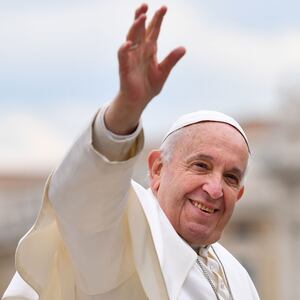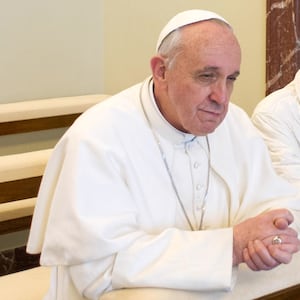ROME—When Pope Francis opened the door to the possibility priests could be married in special cases, a pronouncement he made at the Synod of Bishops on the Amazon Region last October at the Vatican, it nearly split the Catholic world of 1.3 billion followers in two.
Liberal Catholics who have pinned their hopes on this pope modernizing the ancient and powerful patriarchy felt, at last, their time had come. Conservatives, who view this pope as a direct threat to some of their most passionately held beliefs, threatened a schism, going so far as to wheel out Emeritus Pope Benedict XVI (who many still consider their pope) to criticize his successor publicly—even though it later appeared the retired 92-year-old pontiff was just an unwitting pawn.
Francis’ recent predecessors have all refused even to consider the issue of allowing married men to become priests, ruling immediately that celibacy is not negotiable. By not throwing out requests from prelates in the remote regions of the Amazon to ordain deacons to perform sacraments that only priests are allowed to perform, thus reaching out to the faithful who don’t have access to regular clerical visits, Francis set off what could have led to a true schism in the church.
ADVERTISEMENT
Now many are wondering if his choice to close the door firmly was simply in the interest of keeping the church together, but the possibility of a schism still has not been ruled out.
Francis’ Apostolic Exhortation, called Querida Amazonia or “Beloved Amazon,” was released Wednesday in Rome by the Holy See Press Office and followed up by several “syntheses” and canned interviews in multiple languages lest anyone not understand it.
The document is flowery and poetic, focused on the environmental impact of greed and globalization. It doesn’t even specifically mention the request by Amazon church leaders to ordain local deacons who understand the language and culture, but rather urges bishops in Latin America “to be more generous” about encouraging those who “display a missionary vocation” to choose the Amazon region. He also calls the idea of facilitating a greater presence of ordained ministers “narrow” in scope and instead says that lay people (who, by the way, have been carrying all the weight for the church there for decades) should be more involved.
For those who knew ordaining married men was a long shot, there was still a glimmer of hope the pope might “compromise” and instead allow women to be ordained as deacons, who are essentially lighter versions of priests who can do everything except perform the sacraments.
Here, too, Francis closed the door, somehow justifying that giving women more power would somehow compromise the power they supposedly have by not being part of the clergy. Throughout his papacy, Francis has continued to tell nuns and devout Catholic women that by giving them more power in the church hierarchy, he would put them in direct competition with male clergy, implying they would never win that battle.
Francis has exhibited a “woman problem” from the start of his papacy, both in the language he has used and the continuous references to women only as maternal caretakers. In the exhortation, he admits that many communities in far-flung areas are only sustained “because of the presence of strong and generous women” but in the same breath cautions against reducing the Church to “functional structures.”
He warns that giving women power as deacons would lead to a “reductionism” of their role as religious women and lay women in the church. That approach, he says, would “narrow our vision; it would lead us to clericalize women, diminish the great value of what they have already accomplished, and subtly make their indispensable contribution less effective.”
With the idea of giving women more power clearly rejected, he then goes on to applaud women’s contribution to the church, limited as that might be, dubbing it the “tender strength of Mary” before calling for the creation of “new feminine services,” which—with the public recognition of the male bishop—allow their input to affect decisions taken in the community.
“This would also allow women to have a real and effective impact on the organization,” Francis writes. “The most important decisions and the direction of communities, while continuing to do so in a way that reflects their womanhood.”
Conservative Catholic traditionalists have, for the moment at least, dodged the bullet and will have no choice but to be pleased with the contents of the document they have feared for so long. The threat that allowing married men to be ordained as priests—even late in life and even to ensure that all Catholics could be ministered to—would lead the way to the end of celibacy altogether has subsided.
To those extremely devout Catholics—many of whom are not priests but live by self-imposed sexual abstinence—there is no question that priestly celibacy demonstrates an important sacrifice to God, even though it was only instituted as a rule for the clergy about a thousand years ago. Before that, clerical celibacy was not required, and often after that, especially during the Renaissance, it was not honored.
Liberals will see this as a compromise by this pope in order to keep the church united, essentially making the Amazon take one for the team rather than answering the earnest desire of that region’s Catholics to be more devout.
The priest shortage still exists. Catholic communities in some regions still see a priest only once a year. Since the average time it takes for a seminarian to become a priest is five years from college graduation, even if this exhortation sparked a surge in vocations, it would not have any immediate impact on the ministerial void.
The Amazon case could easily have been used as a precedent for how to combat priest shortages in other remote areas. And if a number of regions allow married priests (the Amazon region spans nine countries in South America), then surely the whole world would soon want them.
The celibacy question is one that traditionalists know they could still lose easily. And precisely because sexual abstinence is not written in canonical law, as such, it is subject to a liberal-minded pope who could abolish it altogether.
Most against lifting celibacy tend to fear that it is a step that could liberalize the church in other ways. Opening the door to married priests could lead to ordaining women as priests, some fear. Female priests are not accepted by traditionalists because of the belief that a priest has to be in God’s male likeness.
Another aspect of Francis’ open-mindedness that the conservatives particularly despise links back to his Latin American heritage and his respect for local traditions. On this contentious issue for which he has been widely criticized by mostly European and Americans, his exhortation does not give ground.
During the synod in Rome last fall, Francis allowed representatives from the Amazon to bring along five so-called Pachamama wooden statues which depicted, among other things, a naked, pregnant figure in the likeness of an indigenous Amazonian woman, not the usual white Virgin Mary symbolism associated with mainstream Catholicism.
So angry were many conservatives at the very presence of these “pagan” figures, which were briefly stolen and thrown into Rome’s Tiber River, that they have since used them widely on social media and elsewhere to try to show Francis’ church as one in spiritual decline. Many of these conservatives have accused the pope in an open letter signed by 100 priests and lay scholars of “sacrilegious and superstitious acts” for worshiping “false idols” even though his own intent was to allow the visiting prelates to feel more at home.
Francis addresses this in the text, pouring cold water on those who criticized him. “Let us not be quick to describe as superstition or paganism certain religious practices that arise spontaneously from the life of peoples,” he writes. “It is possible to take up an indigenous symbol in some way, without necessarily considering it as idolatry. A myth charged with spiritual meaning can be used to advantage and not always considered a pagan error.”
The question of married priests and women deacons may be quieted for the moment, but it will surely resurface. The document hints that this case may be closed, but the discussion is not entirely stifled.
“Pope Francis has remained faithful to what he said prior to the Synod,” Cardinal Michael Czerny, a great supporter of the pope and under-secretary of several Vatican congregations, said in an email after release of the document. “The possibility of ordaining married men already exists, for example, in the Eastern Churches. This discussion has been going on for many centuries, and the Synod freely addressed it, not in isolation, but in the full context of the Church’s Eucharistic and ministerial life.”
The official line is, of course, that married Catholic men would not be able to devote themselves entirely to the priesthood if they had spouses and children. Some who support it have gone so far as to say that married priests would help combat pedophilia in the priesthood. But that argument is flawed and would only stand up if it meant that allowing priests to marry would translate to increased interest in the priesthood or might beget better screening of those entering the vocation due to competition. One of the biggest factors in the clerical sex abuse crisis is a clear lack of adequate screening of seminarians who might be prone to pedophilia.
Also, of practical concern to the church may be the upkeep of married priests with large families. Priests often take the vow of poverty, relying entirely on local dioceses for food, housing, and financial support and leaving the church all their possessions when they die. Families would complicate that scenario.







